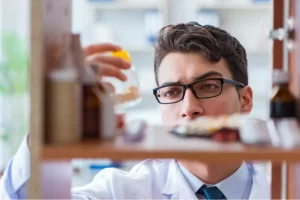
The United States Drug Enforcement Administration (DEA) put together five Schedules (categories or classifications) of controlled substances. Physical addiction appears to occur when repeated use of a drug changes the way your brain feels pleasure. The addicting drug causes physical changes to some nerve cells (neurons) in your brain. Stimulants include amphetamines, meth (methamphetamine), cocaine, methylphenidate (Ritalin, Concerta, others) and amphetamine-dextroamphetamine (Adderall XR, Mydayis).
Popular Articles
- Your doctor can write you a prescription for Narcan, or you can request it at your local pharmacy.
- Therapy and medications are available to help you manage this chronic condition when you’re ready.
- Specifically, the pancreatic stellate cells are activated, resulting in the expected fibrotic changes.
While increased tolerance and dependence must be present for a formal substance use disorder diagnosis, many people become addicted to substances before developing physical dependence and withdrawal symptoms. To prevent relapse after hallucinogen addiction recovery, individuals adopt relapse prevention techniques that reinforce long-term sobriety and provide coping mechanisms for triggers. These strategies involve building healthy routines, fostering a support network, and engaging in regular therapy to address underlying emotional and psychological issues that lead to substance use. As with other diseases and disorders, the likelihood of developing an addiction differs from person to person, and no single factor determines whether a person will become addicted to drugs. In general, the more risk factors a person has, the greater the chance that taking drugs will lead to drug use and addiction.

Non-substance addictions

Contact our admissions team, available 24/7, to start your addictive drugs definition journey towards recovery. Short-term effects of hallucinogen use primarily involve dramatic changes in sensory perception and psychological states. These effects manifest within minutes to an hour after use and last several hours, depending on the substance and dosage. Users experience both euphoric and unsettling sensations influenced by the drug’s interaction with neurotransmitters like serotonin. There is no definition of addiction in the latest version of the Diagnostic and Statistical Manual of Mental Disorders (DSM-IV-TR), but substance abuse is defined for drugs like nicotine, heroin, marijuana, alcohol and others.
Health Conditions
If one plans to initiate treatment, a joint plan involving the patient’s input yields better results. Also, significant variations are based on the stage of addiction and addictive substances. But with continued use, a person’s ability to exert self-control can become seriously impaired. Young children may swallow drugs by accident because of their curiosity about medications they may find. Children younger than age 5 (especially age 6 months to 3 years) tend to place everything they find into their mouth.
Dealing With Relapse
People use hallucinogens because of various psychological and social motivations, including recreational experiences, seeking a sense of euphoria, or enhanced perception during social settings. Others use hallucinogens as a form of escapism, attempting to temporarily avoid stress, trauma, or emotional pain by altering their mental state. Withdrawal symptoms from hallucinogens, though less severe compared to other substances, include intense cravings, anxiety, depression, and sleep disturbances.
- An addiction is a chronic dysfunction of the brain system that involves reward, motivation, and memory.
- The most common hallucinogens are lysergic acid diethylamide (LSD) and phencyclidine (PCP).
- Our editors will review what you’ve submitted and determine whether to revise the article.
- You’ll soon start receiving the latest Mayo Clinic health information you requested in your inbox.
- Many of these drugs, and their relationships, are shown in Figure 1.
What is the most common addiction?
Most people who develop substance use disorder do so for a combination of reasons, including genetics and environmental factors. Regardless of the treatment approach, each method offers education about addiction and recovery. This may include topics like making life changes to support recovery, being honest, seeking help when needed, and practicing self-care.
Mental Health Awards
- Users experience both euphoric and unsettling sensations influenced by the drug’s interaction with neurotransmitters like serotonin.
- This knowledge can be used to develop better care plans with the potential to increase patient compliance and make treatment more effective.
- The effects of hallucinogen use are altered sensory perception, emotional instability, and cognitive disruptions.
- The frontal lobe allows a person to delay feelings of reward or gratification.
- It can damage personal relationships, lead to financial difficulties and cause legal problems.
- Physical addiction appears to occur when repeated use of a drug changes the way your brain feels pleasure.
Substances such as alcohol, marijuana and nicotine also are considered drugs. When you’re addicted, you may continue using the drug despite the harm it causes. Behavioral therapies for hallucinogen addiction focus on modifying harmful thoughts and behaviors to prevent relapse. CBT and DBT significantly reduce relapse rates, making behavioral therapies a cornerstone of effective treatment, with both https://ecosoberhouse.com/ therapies having similar success rates of around 50-60%, as studied by First Session. An addiction is a disorder characterized by the compulsive use of a substance or activity that triggers our reward systems despite experiencing adverse consequences.

How are addictions diagnosed?
Users experience heightened visual and auditory sensations, such as seeing vivid colors or hearing distorted sounds, which result from the drug’s influence on serotonin receptors in the brain. Emotional instability, such as sudden mood swings or feelings of euphoria followed by anxiety, is another common effect, as hallucinogens disrupt the brain’s regulatory processes. Cognitive disruptions include confusion, impaired decision-making, and, in some cases, long-lasting issues Sober living house like flashbacks or Hallucinogen Persisting Perception Disorder (HPPD).
The prevalence of addiction costs the U.S. economy hundreds of billions of dollars every year. If a person experiences a substance overdose, those around them should seek emergency medical assistance immediately. A person who has recovered from an overdose may want to seek professional help to treat their addiction. Addiction is a chronic condition that can also result from taking medications.
Leave a Reply